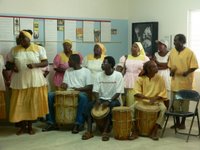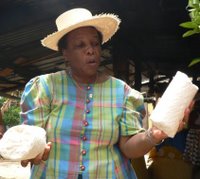Wednesday, July 19
Site Assignment
Belize Audubon Society is the oldest and largest conservation NGO in Belize. Through their mission BAS is "dedicated to the sustainable management of our natural resources through leadership and strategic partnerships with stakeholders in order to create a balance between people and the environment. " In collaboration with the Forest Department, BAS manages nine protected areas throughout Belize.
While Belize Audubon Society has worked with Peace Corps before, I will be their first Peace Corps Volunteer. The primary opportunities outlined for this project are to provide environmental education and community outreach support to BAS programs, parks, and communities through development of activities for kids' corner, developing education materials, implementing outreach activities to communities, the general public, schools, and BAS members. BAS also needs assistance with the development and writing of proposals for grants to support their work. I am very excited to have the opportunity to work Belize Audubon Society to say the least.
Saturday, July 15
Cassava Bread

The Peace Corps group took a bus ride on the Hummingbird Highway to the Stann Creek District of Belize. Our destination was the district capital Dangriga, located on the Caribbean Sea. First, we visited Gulisi Garifuna Museum to learn about the history and culture of the Garifuna people.
Garinagu (plural of Garifuna) or Black Caribs, are descendants of two ethnic groups, Carib Indians and Black Africans, that lived on the island of St. Vincent.
-National Garifuna Council
 Next we visited a Naomi Noralez, who operates a cassava bread making business in Dangriga. Cassava bread is flat, round, biscuit-like, and very dry, so it has a long storage live if stored properly. We learned the traditional method and helped Miss Naomi make some cassava bread. It is a long process so I'll try to sum it up as best as possible. First, the tubers from the cassava plant are harvested, peeled and cleaned. The white tubers are then grated or mortared into a mash that is stuffed into a long woven snake-like basket called a ruguma, which is hung so the water can be strained out. Next the cassava is sifted into a flour through a round woven basket. The cassava flour is then spread onto a large griddle. It is packed down, more flour is sifted on and brushed. Then the whole piece is flipped over. If you think flipping a large pancake is difficult, try this. The edges are trimmed and the the bread is cut into sections, and there you have it, cassava bread!
Next we visited a Naomi Noralez, who operates a cassava bread making business in Dangriga. Cassava bread is flat, round, biscuit-like, and very dry, so it has a long storage live if stored properly. We learned the traditional method and helped Miss Naomi make some cassava bread. It is a long process so I'll try to sum it up as best as possible. First, the tubers from the cassava plant are harvested, peeled and cleaned. The white tubers are then grated or mortared into a mash that is stuffed into a long woven snake-like basket called a ruguma, which is hung so the water can be strained out. Next the cassava is sifted into a flour through a round woven basket. The cassava flour is then spread onto a large griddle. It is packed down, more flour is sifted on and brushed. Then the whole piece is flipped over. If you think flipping a large pancake is difficult, try this. The edges are trimmed and the the bread is cut into sections, and there you have it, cassava bread!
Wednesday, July 12
Chaa Creek
 Today the Environmental Education Trainees attended part of the Summer Teacher Institute workshop, which was put on with the help of two current Volunteers. Belizean and American teachers attended. The purpose of the project was to help teachers incorporate environmental education into primary schools of Belize. The major themes presented were ecology, archeology, and tourism in Belize. The program, which was a week long, was held at Chaa Creek, a private preserve and jungle lodge. It is an amazing place and has received numerous Ecotourism Awards.
Today the Environmental Education Trainees attended part of the Summer Teacher Institute workshop, which was put on with the help of two current Volunteers. Belizean and American teachers attended. The purpose of the project was to help teachers incorporate environmental education into primary schools of Belize. The major themes presented were ecology, archeology, and tourism in Belize. The program, which was a week long, was held at Chaa Creek, a private preserve and jungle lodge. It is an amazing place and has received numerous Ecotourism Awards.We began the afternoon with a tour of the rainforest medicinal trail. Beautiful scenery, situated next to the Mopan River. Our naturalist guide Geovanni was an encyclopedia of knowledge, but I was easily distracted by the sight of a Blue Morpho (Morpho peleides). I had no luck photographing the butterfly, however it is the same as the animated one on my blog. A Mayan healer, Don Elijio Panti from the nearby village of San Antonio, was renowned for his knowledge of plants and herbs used in traditional medicine practice. The knowledge of Don Elijio was preserved when an American doctor, Rosita Arvigo began studying with him. Today Dr. Rosita continues traditional medicine and has her business close to my home in San Ignacio. In talking with my host family, natural medicine is still used and probably more so among the older generation. One relative in the family prefers traditional medicine over what his doctor prescribed for diabetes.
 In addition to medicinals, the trees and plants have many other uses. I learned much about the Cohune Palm (Orbignya cohune) in an activity building session with the other teachers. We were asked to prepare something that could be used in the classroom after reading a short background article about the palm tree. My group performed a drama scene in which we transformed into a cohune palm and each presented a short dialogue about the different tree parts and their uses. The leaves are used for thatched roofs, the heart of the palm and the nuts are edible, the trunk is used in drum making, and etc. The cohune palm is probably the most important tree to the Mayans. Pictured here is the Mayan ruin Xunantunich, notice the large cohune palms on the right side.
In addition to medicinals, the trees and plants have many other uses. I learned much about the Cohune Palm (Orbignya cohune) in an activity building session with the other teachers. We were asked to prepare something that could be used in the classroom after reading a short background article about the palm tree. My group performed a drama scene in which we transformed into a cohune palm and each presented a short dialogue about the different tree parts and their uses. The leaves are used for thatched roofs, the heart of the palm and the nuts are edible, the trunk is used in drum making, and etc. The cohune palm is probably the most important tree to the Mayans. Pictured here is the Mayan ruin Xunantunich, notice the large cohune palms on the right side.
Monday, July 10
Mengo Time

There are two mango trees in my host family's backyard and they're delicious. This Kriol song is the un-official national anthem for Peace Corps Belize...
Mengo Time
Mi noh kyaa weh dehn seh, Mengo time
Mi noh kyaa weh dehn seh, Mengo time
Ah geh mi baaskit ahn krokas beg
Ahn tie mi hed wid eny ole reg
Mengo time, mengo time, mengo time
Mango Time
I don't care what they say, Mango time
I don't care what they say, Mango time
I get my basket and crocus bag
And tie my head with any old rag
Mango time, mango time, mango time
Saturday, July 8
Iguana Project
I saw a wild iguana basking on a log in the Mopan River, on July 4th, when our training group visited a Mayan ruin called Xunantunich. But their population has declined because of hunting. Iguana meat is a delicacy, also known as bamboo chicken. The iguana's eggs are also a delicacy. Although the iguana is now a protected species, I was told they may be seen in the Belize City market and are available in the black market. Enforcement can be difficult because the bush meat comes from rural areas of Belize. Large females with eggs are the most sought after. Smaller iguanas may be captured for the pet trade.
While a green iguana, as large as 7 feet head to tail, may seem scary to some people, it is nothing to be feared. They have sharp teeth and claws but adults are strictly herbivorous. For defense they can display their dewlap, which has sub-tympanic discs that mimic large eyes in order to fool predators. Iguanas are also capable of loosing their tail (autotomy) for defense and it will regenerate. Another interesting tidbit, which I did not know about iguanas, is that they have a third eye on the top of their head that can detect light and dark.



